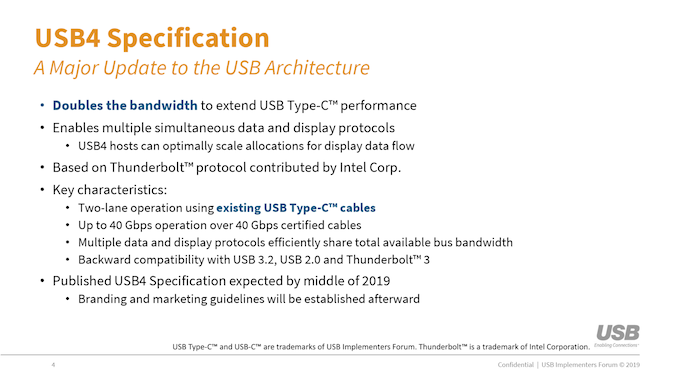USB-IF: USB4 Products Coming in Late 2020
by Anton Shilov on June 12, 2019 8:00 AM EST- Posted in
- Peripherals
- Trade Shows
- USB-IF
- USB
- USB4
- Computex 2019

The USB Promoter Group is hard at work developing the USB4 specification. We met with them at Computex this year, and the good news is that the spec is in its 0.96 version and things are proceeding quickly. The group believes that retail products featuring USB4 will be available by the end of 2020.
Update 16/6: The current USB4 spec is at 0.96.
Being based on Thunderbolt 3 technology and offering up to 40 Gbps bandwidth, USB4 promises to be more than that. In fact, so much more that the USB Promoter Group is considering a new logotype and branding scheme. The current one is already complex enough, so expect some kind of simplification on that front. Meanwhile, USB4 will be backwards compatible with existing USB Type-C devices.
When it comes to availability, USB-IF seems to be optimistic that the specification will be finalized this Summer and actual USB4-supporting devices will be available by the end of 2020. Since Intel knows how to build Thunderbolt 3 controllers, it will certainly use its expertise developing USB4 controllers eventually.











69 Comments
View All Comments
TheUnhandledException - Wednesday, June 12, 2019 - link
Once again it isn't a technology issue. Have you noticed not a single TV has a single displayport port. Way back in the day they did have VGA ports and a few had a single DVI port but once DP became a competitor to the dominance of HDMI that ended. The TV OEMs want a standard they control and they control HDMI so TVs (and other CE devices) will use HDMI. There will be future versions of HDMI with more capabilities, and higher resolutions but it will be HDMI."I believe that TV manufacturer will feel pressure with time to integrate at least one Thunderbolt USB-C connector to connect a laptop to the TV"
You can today. Most laptops with usb-c support HDMI alt-mode. You just need a usb-c to HDMI cable. See the pattern? No matter what the solution is .... HDMI because the consumer electronic OEMs control the HDMI standard.
LogitechFan - Sunday, June 16, 2019 - link
Yeah, because the future is not wireless.... sure.lilkwarrior - Sunday, December 1, 2019 - link
You slim down TVs using tech like MicroLED & OLED; not really the ports you use.Diogene7 - Wednesday, June 12, 2019 - link
It is hard to predict the future of technology 5 to 10 years in the future...So I would say that it is difficult to predict what a TV migh look like in 2025 or 2030, but I am hopefull that it will integrate at least some Thunderbolt USB-C connectors as it would allow to slim down TVs and use a USB-C cable to plug one or several external Thunderbolt docks on it...
I believe that TV manufacturer will feel pressure with time to integrate at least one Thunderbolt USB-C connector to connect a laptop to the TV, as more and more laptops are getting thinner and may soon come equipped with only Thunderbolt USB-C connector (like Apple MacBook Pro computers...)
ksec - Wednesday, June 12, 2019 - link
Thunderbolt 3 was build around the PCI-E 3.0 era, PCI-E 5.0 will be out in 2021, ( Some FPGA even in 2020 ), will there be an update? Or are external PCI-E stops at 3.0 there will be no 4.0 and 5.0?What if we need 6/8K and 120hz?
hpglow - Wednesday, June 12, 2019 - link
PCIE 5 has some sort trace requirements. Most boards won't have it on the farther pci slots. So I'm not sure (unless someone invents some kind of booster chip) if we will see it externally.DanNeely - Wednesday, June 12, 2019 - link
My expectation is that TB4/5 cables will have to switch to fiber with all that means in terms of even higher costs and the inevitable failures when users ignore minimum curvature radius requirements and try tightly folding the cable back on itself.repoman27 - Wednesday, June 12, 2019 - link
Nah, PAM4 signaling at almost the same Nyquist rate with a little FEC thrown in. That's the way things are headed, and copper cables will be fine (or at least as fine as they are now).PCIe Gen 5 is ridiculous in that they went for 32.0 Gbit/s NRZ signaling. That's a 60% higher Nyquist rate than Thunderbolt 3. AFAIK, aside from Intel Agilex and Xilinx UltraScale+ FPGAs, no other commercial transceivers operate at that rate. I have trouble seeing how PCIe 5.0 makes it to consumer devices anytime soon.
TheUnhandledException - Wednesday, June 12, 2019 - link
I am sure TB will be updated again. TB4 at 80 Gbps? However TB has generally lagged behind the underlying PCIe spec by three years. I wouldn't expect to see TB4 before 2022 and TB5 may never happen at least not just routing 4 PCIe 5 lanes given the serious constraints on even internal PCIe 5.Side note TB3 should be able to do 8K 10bit HDR 120 Hz using dual DP 1.4 streams and DSC. It is right on the line though but 100 Hz is certainly possible.
repoman27 - Wednesday, June 12, 2019 - link
Even at 7680 x 4320 with a full 3:1 compression ratio, 120 Hz is too much when you factor in the CVT requirements. 112 Hz is the cutoff, but 110 Hz is probably the highest practical rate.